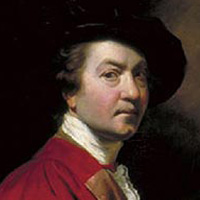Discourse on Art by Sir Joshua Reynolds: An Overview
Sir Joshua Reynolds in 'Discourse on Art' seems to build a principle of aesthetics. He refutes the idea that beauty does not follow rule. Rather he puts emphasis on the principles that make a work of art beautiful, the principles that assist “clearing the mind confused heap of contradictory observations” (347). The great painters follow the same principles of beauty.

Sir Joshua Reynolds (1723-92)
Reynolds believes that the artist should go to heaven for the search of ideal perfection and beauty, which are on earth and within us; they are substratum of our own humanity. Empirical experience can explore artistic part of out own humanity; for this, the artist look beyond particularities because “the whole of beauty and grandeur of the arts consists in being able to get above all singular forms, local customs, particularities and detail of every kind” (344).
Though nature is beautiful, it still has “blemishes and defects” imperceptible to ordinary man (344). It suffers from weakness and imperfection. The artist tries to impose idea of beautiful form in nature; “he corrects nature by herself, her imperfect state by her more perfect… he makes out an abstract idea of… forms more perfect than any one original” (344). This is the great principle of art.
Since “art is not a divine gift, so neither is it a mechanical trade. Its foundations are laid in solid science and practice, through essential to perfection, can never attain that to which it aims, unless it works under the direction of principle” (347).
Genius produces art and taste produces judgment of art. Both genius and taste are inborn faculties of empirically sensitive mind. Taste determines prejudices and prejudices force us in the pursuit of taste. Beauty is the matter of taste. The idea of beauty is accomplished in the work of art “with which it is natural for the mind to be pleased, whether it proceeds from simplicity or variety, uniformity or irregularity; whether the scenes are familiar or exotic; rude and wild; or enriched and cultivated; for is natural for the mind to be pleased with all these in their turn” (351). Truth can be pleased when its taste is addressed. Truth is in uniform with taste. Truth varies as taste varies. Taste even stifles reason. That does not mean art should be away from reason. Reason helps on reflection in the process of art. The principles of taste are numerous that assist us to owe the value of different ranges of the art. The corrupt taste of the mind must be disallowed in the art because it breeds apparent. The pure and uncorrupted taste is the matter of uniformity of sentiments among humankind leading us to the ideas of perfect beauty.
The art criticism requires habits of speculation and abstraction. Since art belongs to the faculties: imagination and sensibility of mind, art criticism should have foundation of the principles of those faculties. On the whole the aim of art is to supply the natural deficiencies of thing and so as to gratify the mind by the realization and embodiment in imagination. Art address not to the “gross senses but to the desires of the mind, to that spark of divinity which we have within…” (363).
Reynolds says about the skill of young artist. They should practice and go beyond mere imitation of nature to the excellences. They should achieve aesthetic quality. He goes on talking about genuine and false painters in his “Discourses”. Genuine painters shape their art from their grandeur thoughts. It is not the slavish following of the classical but their grandeur efforts. He further distinguishes reason based knowledge and enthusiasm and believes in inspiration and says that the painters to be simply the medium, do not consider reason. He says that such art does not provide knowledge. There has to be rational faculty.
Reynolds is of the opinion that the young artists should be analytical. There is no existence of inspiration etc. They eyes of genuine artist should contemplate, that provides them the commonality. Perfection is the imaginary thing and beauty can be found in totality. The idea of beauty is invariable. An artist’s job is to find that sort of beauty that is common to all. We should release us form all the prejudices and focus on general things. The art should be addressed not to the eyes only but through the eyes to the imagination.
